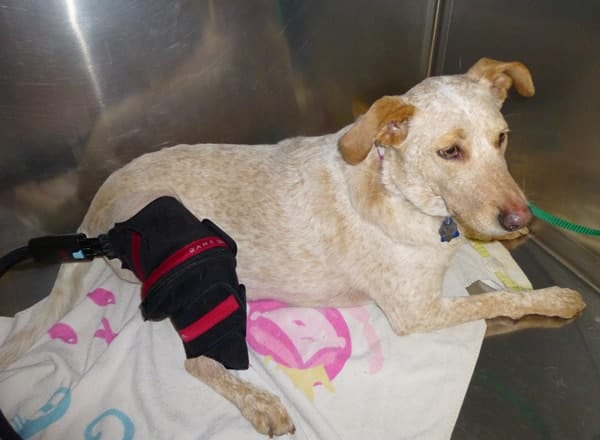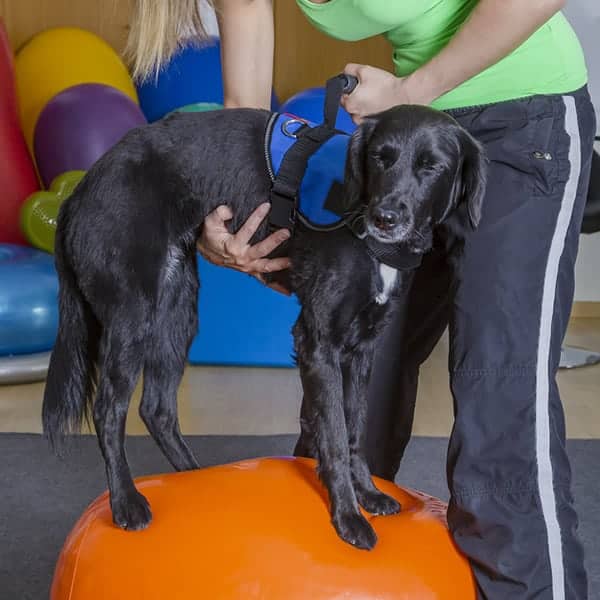WRITTEN BY: Harrie Phillips
BAdVocEd (VocEd&Trng), RVN, DipVN (Surgical, ECC), DipBus, DipTDD, TAA.

You’d probably be familiar with using cold packs when you injure yourself, such as when you sprain your ankle. The use of cold therapy (more correctly termed cryotherapy) has long been used to assist in pain management and the control of inflammation and swelling in both human and veterinary patients. It’s a great physical therapy modality that veterinary nurses can use as part of their overall nursing care plan.
Cryotherapy is often overlooked in the general practice setting, but it is a very effective method providing pain relief in our post operative patients – and I’m not just talking about our orthopaedic patients, but our routine surgical cases too. It also plays a very important part of any rehabilitation plan. In one human study, it was found that those patients who utilised cryotherapy in the immediate post op period reported less pain and better sleep than those who didn’t. Continued use in the next 10 days as part of the rehabilitation plan reported benefits like less swelling, ability to move more, less pain during rehabilitation exercises and overall reduced pain1.
Cryotherapy induces vasoconstriction, which decreases tissue blood flow. This in turn then reduces oedema (swelling) that usually forms from the lymphatic and venous drainage into the injured area. It also decreases tissue metabolism and enzyme activity, slowing the inflammatory response. Muscular activity and nerve conduction are also decreased, which reduces muscles spasms and pain (numbing action). By using cold (and limiting swelling), the formation of scar tissue will be minimised, and thus future problems, such as tissue shortening and joint and muscle contracture, can also be minimised.
Once cryotherapy has ceased, the benefits continue – vasodilation will occur which then brings in a flood of nutrients and cells essential for wound healing.
Ok, so now we know how it works, when do we use cryotherapy?
Cryotherapy should be initiated as soon as possible after surgery (once the patient’s body temp is normal). Although it is important for inflammation to occur in order to achieve effective healing, excess bleeding and swelling can be counter-productive to a good functional outcome and lead to an increase in pain.
Always check with the veterinarian if the patient is a suitable candidate, as a veterinary nurse, you can under take the actual treatment. You could also utilise your ward or kennel assistants once you have provided them with some training.
The technique is of most use in the acute phases of inflammation to minimise blood loss and swelling. Chart your patients for their first round as soon as they are recovered from the anaesthetic and their body temperature is normal. Continue for the first 2-3 days after surgery, so you’ll want to instruct the owners as well.

Game Ready Commercial Cryotherapy Unit on Veterinary Patient.
Photo Credit: Middletown Animal Hospital
So I just put an ice pack on the surgical site?
Yes and no.
Commercial cold or ice packs are one of the cheapest and readily available methods, although there are also commercial cryotherapy units you can purchase (Game Ready, Cryo-cuff etc).
You can also make your own as with an isopropyl alcohol and water mix (1:3) in a heavy-duty ziplock bag.
There are a few rules you need to follow when using cold or ice packs.
- Never apply the cold pack directly to the skin as it can cause cold burns. Ensure it has a protective layer, such as a damp small towel over it2. Ensure it’s not too thick however; we don’t want to stop the cold from reaching the tissues.
- Never apply to wet hair – ensure your patient is dry.
- If the patient has an orthopaedic implant, do not place the cold pack on top of its location. The implant can act as a bridge and the ensuing cold can do deep tissue damage.
- Do not use if there is compromised blood flow or areas of reduced circulation. Causing further vasoconstriction in these areas can lead to hypoxemia and necrosis.
- Monitor your patient for signs of discomfort, especially if they are not ambulatory (either through the anaesthetic recovery or their injury or disease). These patients are unable to move away from the cold source.
- Don’t leave your patients unattended with their ice packs. Sure the commercial ice packs are non-toxic, but who wants to clean that up after it’s been ingested?
- Compression and elevation are also important. If you can use a compression wrap or bandage to hold the ice pack on, then do it. Compression can assist with cold conductivity and help reduce oedema and haematoma formation. Just don’t put it too tight and reduce the venous flow too much, it could lead to a thrombosis3. Elevation is much harder to achieve in our patients, so if you can’t, just keep the oedematous side up.
- Don’t use on open wounds.
How long do we do it for?
Length and frequency will vary depending on the injury itself and the desired outcome. For most postoperative patients, cryotherapy needs to be performed for 10 to 20 minutes each application, 2 to 4 times per day2, 4.
As part of a rehabilitation plan, it can also be performed after an exercise session to reduce reactive swelling and pain.
What about heat?
Heat, or thermotherapy, should never be used in the initial stages of an injury/immediately post op, as the improved circulation will lead to increased bleeding and swelling. However, after the first 3-5 days, once the active swelling has ceased, heat can then be effectively used. The increase in circulation caused by the heat helps to remove the remaining swelling, and promote the repair processes. Heat can also be effective in relaxing muscle tissue and softening newly formed scar tissue, to allow more effective stretching and exercising to occur, and a quicker return to normal range of motion.
Ice Massage
You can also make your own ice massage sticks (just freeze a tongue depressor in a disposable cup filled with water). Ice massage can be applied direct to the skin – its a simple circular massaging movement (don’t stop the ice from moving however, we don’t want to cause ice burns!). Ice massage is great for targeted cryotherapy and massage.
Want to know more about Physical Therapy?
We have a great short course aimed at Veterinary Nurses that includes massage, cryotherapy, passive and active assisted exercises and more – click here to learn more and register.
References
- Speer KP1, Warren RF, Horowitz L. The efficacy of cryotherapy in the post operative shoulder. Journal of Shoulder & Elbow Surgery. 1996 Jan-Feb;5(1):62-8.
- Zink MC, Van Dyke, JB. Canine Sports Medicine and Rehabilitation. Pg. 117. Wiley Blackwell., 2013.
- Martin SS, Spindler KP, Tarter JW, et al. Cryotherapy: An Effective Modality For Decreasing Intraarticular Temperature After Knee Arthroscopy. Am J Sports Med 29:288-291, 2001.
- Macauley DC. Ice Therapy: How Good Is The Evidence? Int J Sports Med 22:379-384, 2001.
want to learn more?

Physical therapy
SHORT COURSE
Physical therapy is an essential part of the post op recovery period and an area of care where nurses can be actively involved. Providing physical therapy is a great way to improve owner compliance with post op care, and allow regular contact with the clinic to monitor the patient’s progress. This subject will prepare students to discuss physical therapy with clients, devise routines they can follow, and recognise when to refer to a veterinary physiotherapist. It also covers techniques they can implement in clinic to help speed up the recovery of the post op patient. This subject will also teach students about the various muscles and muscle groups.
Check it out